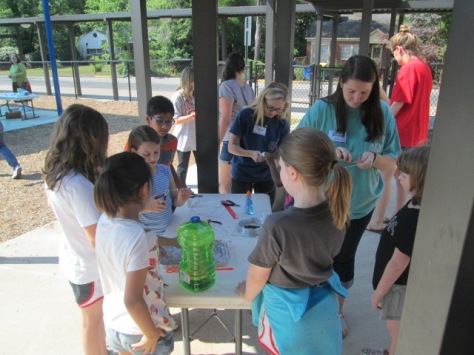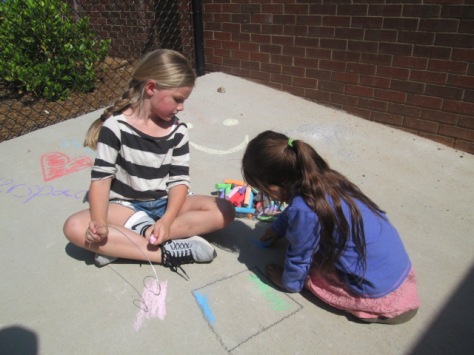

We returned from fall break this year on Halloween. The kids were of course pulsing with energy as they awaited a night of trick or treating, so we held a special makerspace session to harness their energy and have some fun. Gretchen Thomas and I already wanted to try something a little different on Halloween for makerspace. When her group of UGA students started investigating Halloween and fall themed makerspace activities, they asked if they all could come instead of just one small group. So…half of her class came at 11:00 and half came at 11:30 and we added extra slots to our signup sheet. We had anywhere from 25-40 students who signed up for each session.
There were 5 stations for students to choose from and each station had UGA students to support students.
Ghost Rockets
Students made 3-dimensional ghosts out of paper and launched them into the air by putting them onto the end of a straw and blowing. Many students adjusted their ghost design or tried different techniques for launching.
Catapults

Students used Popsicle sticks, spoons, and rubber bands to create catapults that would launch pom pom balls into the air. A Halloween treat bucket was the target, but students also loved becoming the target themselves. This was a rowdy but fun center, and once again, we saw students adjust their designs for a better launch or even build catapults that would launch 3 pom poms at a time.

Leaf Chromatography

Students folded coffee filters into triangular shapes and colored them with markers to make a color pattern. Then, they dipped the filters into water to see how the colors would move across the coffee filter. This center needed a drying area since each filter was very wet after the activity.

Make a Monster
Students used a variety of supplies to design their own monsters. This included cupcake wrappers, pipe cleaners, eye stickers, pom poms, glue dots, and more. The thing I loved the most about this center was the character traits that each monster developed. Many students described their monsters in great detail as they worked and developed an impromptu story about each one. Again, students would look at their design and think about what they could add. Some even created parts of their monsters that moved so that they truly came to life.


Haunted House Construction

Students used Strawbees and straws to construct haunted houses. This center evolved as we went, and many students started building other things along the way too. For example, a student built a bird cage with a perch, but the bird was invisible because it was a ghost. Another student build a table-length monster and we talked about how he could have added paper onto his Strawbee skeleton to make a complete monster.

There was a lot of energy, noise, and fun during this makerspace, but it was so organized and focused. Students were engaged the entire time and had many options of what to go to. I wouldn’t run makerspace like this every time, but it was a great alternative to get more kids into the space and meet a variety of needs. Thank you Gretchen Thomas and UGA students for an awesome day of learning and fun.


























